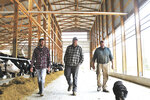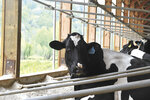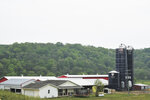


LUANA, Iowa — The only thing the Martins family would change about their robotic milking system is to have done it five years earlier.
“I have yet to find a negative,” Dan Martins said.
Dan and his sons, Drew and Adam, recently put in Lely robotic milking units as part of a greater project that helps financially equip Drew and Adam to take over the farm. The family milks 160 cows. They farm 925 acres for feed and cash crops and rent additional acres for pasture.
The Martins started milking in their new facility Oct. 31, 2023. Their project included the addition of 117 free stalls, the robotic milking units and new manure storage that almost triples their manure capacity.
Drew said the project came as part of their transition plan.
“We knew that to buy Mom and Dad out, we’d have to produce more to pay for (equipment),” Drew said. “The parlor was ... small and old and falling apart.”
Their old facility was a double-6 parlor built in the early 1990s. Milking took three or more hours, morning and night.
The Martins felt an increase from twice-a-day milking to three times a day was necessary to stay economically viable. When considering labor costs on top of the costs for a new parlor, they said it made sense to spend more to get robotic milking units.
“We were definitely more biased towards robots,” Drew said. “We did price a parlor, but ... we looked at it for like 10 minutes.”
The Martins family said they have noticed the change in their schedules.
“The biggest, greatest thing for me, is I get to see my wife and kids more,” Drew said.
Drew and his wife, Whitney, have four children: Harlow, Haven, Trace and Knox.
Adam said he is able to get to his children’s sporting events easier with the new setup. Adam has four children: Brooklynn, Peyton, Maryn and Porter.
“I was married to the parlor, versus now I get to enjoy a little more flexibility with them,” Adam said.
Dan’s wife, Coleen, works off the farm at a daycare in Monona.
The Martins said during planting they were able to keep going versus stopping for chores. They do 80% of their chores in the morning.
“One guy can handle chores easily in a fraction of the time it took both of us to do everything before,” Drew said.
In the robotic setup, they are averaging 3.1 milkings.
“With the shrinking profit margins, you have to make it up in volume, unfortunately,” Drew said.
Adam agreed.
“Efficiency is the name of the game,” he said.
The Martins family also added activity monitors. Before, they used a breeding wheel and their records were hand recorded.
“With all the data, now we can really single out cows that aren’t producing,” Adam said. “We can do a better job of managing.”
He said it is also easier to spot cases of mastitis.
Drew agreed.
“You know that they’re going to be sick before they know,” he said. “You can really start to set the bar high and sharpen your pencil.”
The Martins family said their operation is past the transition phase. They have been able to reduce their pellets in the robotic milking units from 12 pounds to 10 pounds per day.
With their new setup, they separate their two-year-old heifers from the rest of the herd and feed them a different ration.
Drew said the older cows are more stubborn about learning the robotic setup.
“(They are) set in their ways,” Drew said. “They don’t want to change, but they do eventually give in and adapt.”
Their project began by breaking ground on the manure pit in September 2022. Their previous pit’s capacity was 600,000 gallons. Their new manure storage is 1.6 million gallons. While it was being built, they had to haul manure daily from a small, temporary pit.
Before they were able to build new manure storage, the Martins family worked on permits. This was a challenge because there is a stocked trout stream running down the bluff nearby and their manure storage borders a flood plain. However, the Martins said everyone was good to work with.
“They (were) all worried about our best interests,” Drew said.
Construction began on the freestall barn in April 2023. The Martins family moved their dry cows to pasture and housed their milk cows in their dry cow facility. They continued milking in the parlor which was in a separate building from the one in which the robotic milking units were being installed.
“Looking back, I don’t know how we did everything and still managed the cows amongst the chaos,” Drew said.
Before building, the family toured about seven dairy farms.
“I always say ... it’s good to learn from your own mistakes, but it’s better to learn from somebody else’s,” Drew said.
During the building process and the farm transition, the Martins family used a farm management professional to facilitate conversations. Adam said for those going through transition, the group needs to sit down and have good communication.
“Problems have to be on the table before you start,” Adam said. “You have to work out the issues. Everybody’s going to (need to) be on the same page.”
Drew agreed.
“I’d be lying if I said it was a walk in the park,” he said. “At the end of the day there’s a job to be done and you have to put problems aside. ... We all have the same goal, so we’re all working for the same thing.”
Looking to the future, the Martins family said they may expand again. Their mono-slope freestall barn could be doubled. They also want to update their dry cow facility.
“Right now, paying down the debt (is our big concern), and we are trying to put this one in our rearview mirror,” Drew said.
Comments
No comments on this item Please log in to comment by clicking here